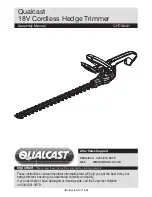
IE
GB
25
b)
Do not operate power tools in
explosive atmospheres, such as
in the presence of flammable
Iiquids, gases or dust.
Power tools
createsparkswhichmayignitethedust
or fumes.
c)
Keep children and bystanders
away while operating a power
tool.
Distractions can cause you to
lose control.
2) ELECTRICAL SAFETY
a)
Power tool plugs must match
the outlet. Never modify the
plug in any way. Do not use
any adapter plugs with earthed
(grounded) power tools.
Unmodi
-
fiedplugsandmatchingoutletswill
reduce risk of electric shock.
b)
Avoid body contact with earthed
or grounded surfaces, such as
pipes, radiators, ranges and re-
frigerators.
There is an increased risk
of electric shock if your body is earthed
or grounded.
c)
Do not expose power tools to
rain or wet conditions.
Water
enteringapowertoolwillincreasethe
risk of electric shock.
d)
Do not abuse the cord. Never
use the cord for carrying, pull-
ing or unplugging the power
tool. Keep cord away from
heat, oil, sharp edges or moving
parts.
Damaged or entangled cords
increase the risk of electric shock.
e)
When operating a power tool
outdoors, use an extension cord
suitable for outdoor use.
Use of a
cord suitable for outdoor use reduces
the risk of electric shock.
f)
If operating a power tool in a
damp location is unavoidable,
use a RCD (Residual Current
Device) protected supply with
a rated leakage current of not
more than 30 mA.
Use of an RCD
reduces the risk of electric shock.
3) PERSONAL SAFETY
a)
Stay alert, watch what you are
doing and use common sense
when operating a power tool.
Do not use a power tool while
you are tired or under the influ
-
ence of drugs, alcohol or medi-
cation.
A moment of inattention white
operatingpowertoolsmayresultin
seriouspersonalinjury.
b)
Use personal protective equip-
ment. Always wear eye protec-
tion.
Protectiveequipmentsuchasdust
mask,non-skidsafetyshoes,hardhat,
orhearingprotectionusedforappro-
priateconditionswillreducepersonal
injuries.
c)
Prevent unintentional starting.
Ensure the switch is in the off-
position before connecting to
power source and/or battery
pack, picking up or carrying the
tool.
Carryingpowertoolswithyour
fingerontheswitchorenergisingpow-
er tools that have the switch on invites
accidents.
d)
Remove any adjusting key or
wrench before turning the pow-
er tool on.
A wrench or a key left at
-
tachedtoarotatingpartofthepower
toolmayresultinpersonalinjury.
e)
Do not overreach. Keep proper
footing and balance at all times.
Thisenablesbettercontrolofthepower
toolinunexpectedsituations.
f)
Dress properly. Do not wear
loose clothing or jewellery. Keep
















































